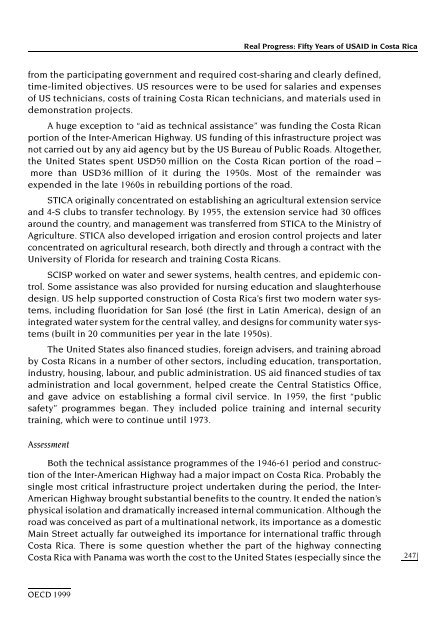Evaluating Country Programmes - OECD Online Bookshop
Evaluating Country Programmes - OECD Online Bookshop
Evaluating Country Programmes - OECD Online Bookshop
Create successful ePaper yourself
Turn your PDF publications into a flip-book with our unique Google optimized e-Paper software.
<strong>OECD</strong> 1999<br />
Real Progress: Fifty Years of USAID in Costa Rica<br />
from the participating government and required cost-sharing and clearly defined,<br />
time-limited objectives. US resources were to be used for salaries and expenses<br />
of US technicians, costs of training Costa Rican technicians, and materials used in<br />
demonstration projects.<br />
A huge exception to “aid as technical assistance” was funding the Costa Rican<br />
portion of the Inter-American Highway. US funding of this infrastructure project was<br />
not carried out by any aid agency but by the US Bureau of Public Roads. Altogether,<br />
the United States spent USD50 million on the Costa Rican portion of the road –<br />
more than USD36 million of it during the 1950s. Most of the remainder was<br />
expended in the late 1960s in rebuilding portions of the road.<br />
STICA originally concentrated on establishing an agricultural extension service<br />
and 4-S clubs to transfer technology. By 1955, the extension service had 30 offices<br />
around the country, and management was transferred from STICA to the Ministry of<br />
Agriculture. STICA also developed irrigation and erosion control projects and later<br />
concentrated on agricultural research, both directly and through a contract with the<br />
University of Florida for research and training Costa Ricans.<br />
SCISP worked on water and sewer systems, health centres, and epidemic control.<br />
Some assistance was also provided for nursing education and slaughterhouse<br />
design. US help supported construction of Costa Rica’s first two modern water systems,<br />
including fluoridation for San José (the first in Latin America), design of an<br />
integrated water system for the central valley, and designs for community water systems<br />
(built in 20 communities per year in the late 1950s).<br />
The United States also financed studies, foreign advisers, and training abroad<br />
by Costa Ricans in a number of other sectors, including education, transportation,<br />
industry, housing, labour, and public administration. US aid financed studies of tax<br />
administration and local government, helped create the Central Statistics Office,<br />
and gave advice on establishing a formal civil service. In 1959, the first “public<br />
safety” programmes began. They included police training and internal security<br />
training, which were to continue until 1973.<br />
Assessment<br />
Both the technical assistance programmes of the 1946-61 period and construction<br />
of the Inter-American Highway had a major impact on Costa Rica. Probably the<br />
single most critical infrastructure project undertaken during the period, the Inter-<br />
American Highway brought substantial benefits to the country. It ended the nation’s<br />
physical isolation and dramatically increased internal communication. Although the<br />
road was conceived as part of a multinational network, its importance as a domestic<br />
Main Street actually far outweighed its importance for international traffic through<br />
Costa Rica. There is some question whether the part of the highway connecting<br />
Costa Rica with Panama was worth the cost to the United States (especially since the<br />
247

















![CQE=U]^\]Z: KAZAKHSTAN - OECD Online Bookshop](https://img.yumpu.com/3915768/1/190x253/cqeuz-kazakhstan-oecd-online-bookshop.jpg?quality=85)